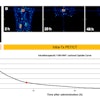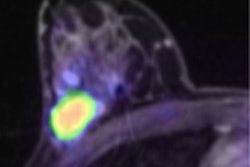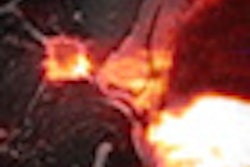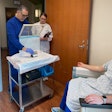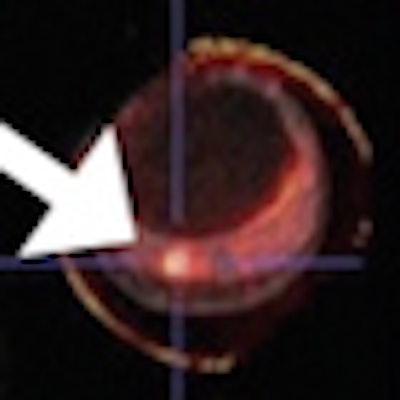
While there is still much work ahead, breast MRI developer Aurora Imaging Technology and the Brookhaven National Laboratory say preliminary results from a work-in-progress PET/MRI breast scanner are promising, with the system detecting breast lesions smaller than 5 mm.
The reason for the optimism comes from a feasibility study conducted at Taipei Medical University in Taiwan, in which the PET/MRI system detected breast lesions with a depth resolution of less than 2 mm in the four patients who were scanned.
By combining anatomical and functional information within the same scan, the technology "allows us to use the sensitivity of MRI with the selectivity of PET," said David Schlyer, PhD, a senior scientist at Brookhaven. "We think we have come up with a valuable diagnostic tool that allows us to see very small lesions."
One of the advantages of this technology is that it is completely compatible with magnetic fields, he added, which was not the case with previous PET scanners using photomultiplier tubes.
Brookhaven began to develop the PET portion of the technology on its own as far back as 2000. The original idea was to make a PET scanner so small that an animal could carry it on its head. From there, researchers developed a miniaturized PET scanner using an electronic application that allows for the imaging of radioisotopes, such as FDG.
About eight years ago, Brookhaven joined with Aurora to incorporate PET and MRI into a single device. The goal was to combine Brookhaven's PET technology with Aurora's breast MRI to create "a sophisticated and diagnostically important breast imaging system" to detect breast cancer, Schlyer said.
System configuration
The design of the work-in-progress system has a patient lie facedown on a table with her breast hanging through an opening on the gantry. There is no breast compression as in a mammogram, so the scan is more comfortable for the patient, according to Xiaole Hong, PhD, vice president of product development at Aurora.
If a clinician sees something suspicious on the MRI scan, he or she then can perform a simultaneous PET and MRI exam. "For this particular application, we can bring the scanner right next to the breast and around the breast. Therefore, it is very sensitive to the radioactivity in the breast and we can get a very clear image," Schlyer said.
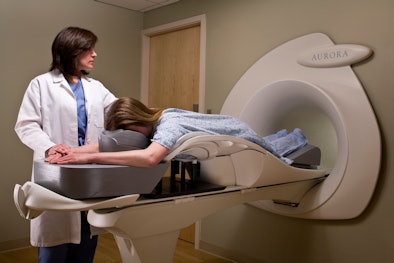 |
| The Aurora PET/MRI prototype has the patient lie facedown with her breast hanging through an opening on the gantry with no compression. All images courtesy of Aurora Imaging Technology. |
The belief is that patients with dense breasts would benefit greatly from the PET/MRI scanner. "Many states have passed legislation that puts patients with dense breasts in a special category for monitoring," Hong said. "I think MRI is a great tool to stand out from the general x-ray-based imaging systems. Combined with the PET, it makes a great diagnostic tool with the highest sensitivity."
High-risk patients
Schlyer stressed that PET is not meant to be a screening tool for the general population; however, it could be useful for high-risk patients who have a family history of breast cancer and certain markers that could indicate a high probability of developing the disease.
One of the key benefits of this hybrid imaging technology is the reduced amount of radiation for the patient. The dose of FDG is the same as in other clinical studies, and radiation exposure is similar to what a patient may receive from a whole-body CT scan, Schlyer said.
The greatest technological difference between the Aurora-Brookhaven PET/MRI technology and other PET/MRI systems is the electronics. "We have been able to condense all the electronics onto a single chip that allows us to take what comes off of our chip -- which is about 1 by 1 cm and less than 1-mm thick -- as a digital signal," Schlyer said.
In addition, instead of large cables running from larger PET/MRI systems, the Aurora-Brookhaven device has only two fiber-optic cables.
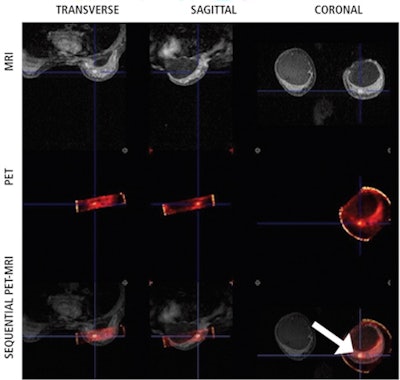 |
| The images show a silicone implant with an invasive micropapillary carcinoma. A dose of 8.67 mCi FDG was used for the PET image. |
Expanded applications
As the technology progresses, it could potentially open the door to other clinical applications such as prostate cancer, Schlyer speculated.
"We have talked about organ-specific detection systems, but the breast lends itself very nicely to this technology," he added. "Because of the work that has been done by Aurora in developing this dedicated breast MRI scanner, we have a huge head start with that application. So, our goal is to prove the technology for this application, get some acceptance in the clinical community, and then try to expand it to other applications."
Currently, Brookhaven and Aurora developers are building and testing a four-ring detector PET/MRI system. (The feasibility study in Taiwan was done with a one-ring detector system.) The four-ring system would provide a larger field-of-view and greater sensitivity. The plan is to get the scanner into a clinical trial within a year or so.
The ultimate goal, he said, is to eliminate unnecessary biopsies. "If we can identify to a physician's or breast surgeon's satisfaction that this is a benign lesion or a malignant lesion, we can avoid having to do biopsies," Schlyer said. "Approximately 80% of biopsies turn out to be negative, so we would like to reduce the number that need to be done."



